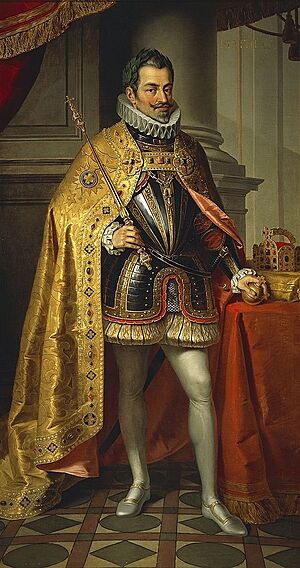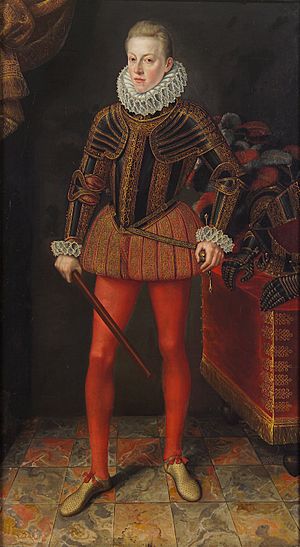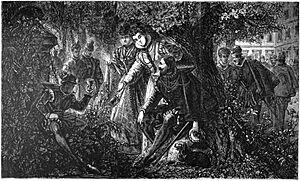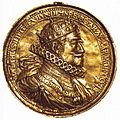Matthias, Holy Roman Emperor facts for kids
Quick facts for kids Matthias |
|
|---|---|
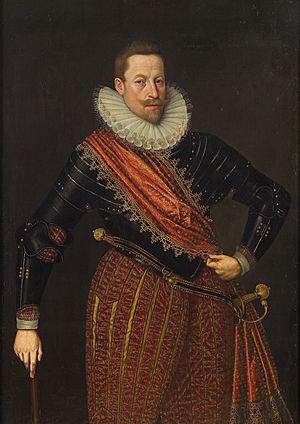
Portrait by Lucas van Valckenborch, 1583
|
|
| Holy Roman Emperor (more...) | |
| Reign | 13 June 1612 – 20 March 1619 |
| Proclamation | 26 June 1612, Frankfurt |
| Predecessor | Rudolf II |
| Successor | Ferdinand II |
| Born | 24 February 1557 Vienna, Austria |
| Died | 20 March 1619 (aged 62) Vienna, Austria |
| Burial | Imperial Crypt |
| Spouse |
Anna of Tyrol
(m. 1611; died 1618) |
| House | Habsburg |
| Father | Maximilian II, Holy Roman Emperor |
| Mother | Maria of Austria |
| Religion | Roman Catholicism |
Matthias (born February 24, 1557 – died March 20, 1619) was an important ruler in Europe. He was the Holy Roman Emperor from 1612 to 1619. He also ruled as Archduke of Austria (1608–1619), King of Hungary and Croatia (1608–1618), and King of Bohemia (1611–1617). His personal motto was Concordia lumine maior, which means "Unity is stronger in the light."
Matthias played a big part in his family's disagreements against his brother, Emperor Rudolf II. After he gained power, he didn't make many of his own big political decisions. Most of his policies were guided by Cardinal Klesl until 1618. Towards the end of his rule, problems with his religious rules and how he managed things led to the Bohemian Revolt. This revolt was the first major event of the Thirty Years' War, a very long and destructive conflict.
Contents
Meet Emperor Matthias
His Family and Early Life
Matthias was born in Vienna, the capital of Austria. He was the fourth son of Maximilian II, Holy Roman Emperor, and Maria of Spain. His brothers included Rudolf, who became Emperor, and Albert, who later governed the Netherlands. He also had six sisters. His sister Anna married King Philip II of Spain.
We don't know much about Matthias's childhood. One of his teachers was a famous writer named Ogier Ghislain de Busbecq. When his father, Maximilian II, died, his eldest brother Rudolf inherited everything. Matthias and his other brothers received money and important jobs in the church or government.
In 1595, Matthias married his cousin, Archduchess Anna of Austria. They did not have any children who survived.
Governor in the Netherlands
In 1578, Matthias was invited to the Netherlands by the local leaders who were rebelling against Spanish rule. They offered him the job of Governor-General. Matthias accepted, even though the King of Spain, Philip II of Spain, did not agree with this.
Matthias helped set up rules for religious peace in the provinces. His work is mentioned in the 1579 Union of Utrecht, which allowed different religions to be practiced in certain areas. Matthias remained the governor for the rebels until they declared full independence from Philip II in 1581. After that, he returned home to Austria.
Governor of Austria
Matthias returned to Austria in 1583 and lived in Linz. He tried to become a bishop in several cities but wasn't successful. He also tried to become the King of Poland.
In 1593, his brother Ernest became the governor in the Netherlands. This finally allowed Matthias to become the governor of Austria. He immediately faced strong demands from Protestants in Austria who wanted their religious rights protected. Problems grew worse because of high taxes and the soldiers needed for the Long Turkish War. Farmers in Austria even revolted in 1595 and 1597, hoping to talk with the emperor. Matthias used hired soldiers to stop these uprisings.
After the revolts, Matthias changed his religious policies. He had once allowed Protestants in his court, but now he became very strict about supporting the Counter-Reformation. His main advisor, Melchior Klesl, was a strong supporter of the Counter-Reformation.
Family Power Struggles
The Habsburg family was worried about Emperor Rudolf II, who was getting older and showing signs of mental decline. After his brother Ernest died in 1595, Matthias became the oldest of the archdukes. From 1599, Matthias tried to convince Rudolf, who had no children, to name him as his successor. Rudolf refused.
The situation became more serious in 1604 during an uprising in Hungary. Matthias avoided arguing with the emperor at first. But Cardinal Klesl pushed him to take charge in the family conflict with Rudolf. In 1600, Matthias and his brothers signed an agreement to work together against the emperor. In 1606, they declared Rudolf mentally unfit to rule and made Matthias the head of the family.
It was Matthias, not the emperor, who made peace with the Ottomans in 1606. He also ended the conflict in Hungary by allowing religious freedom there and letting Transylvania choose its own independent princes.
As unrest continued in Hungary and spread to Moravia and Austria, Matthias used this to gain more power from the emperor. He joined forces with the rebellious Hungarian and Austrian leaders in 1608. In April 1608, Matthias marched on Prague and surrounded the city. He forced Rudolf to negotiate and sign a peace treaty in June 1608. This treaty changed who ruled what. Rudolf kept Bohemia, Silesia, and Lusatia. Matthias received Hungary, Austria, and Moravia.
However, Matthias's takeover of power wasn't smooth. He didn't promise to protect the rights of the local leaders before they officially accepted him as ruler. He tried to change this order, which led to a dispute. Since most of the leaders in Austria and Moravia were Protestant, they formed a powerful group called the Horner Confederation. They only accepted Matthias as ruler after he promised to protect their religious rights. This group continued to exist until the start of the Thirty Years' War.
Matthias as Emperor
Matthias was crowned King of Bohemia on May 23, 1611. After Rudolf's death on January 20, 1612, Matthias was elected Holy Roman Emperor. On December 4, 1611, he married his cousin, Archduchess Anna of Austria, but they had no children.
After 1612, the main court and government offices moved from Prague to Vienna. Matthias was less interested in art than Rudolf II, so many court artists left. However, Matthias remained close with the painter Lucas van Valckenborch. Matthias's wife founded the Capuchin Church and the Imperial Crypt in Vienna, which became the burial place for the Habsburg family. Matthias is said to have found a spring in the area of today's Schönbrunn Palace. He supposedly named the area and the palace by saying, "Look, what a beautiful spring!" (schön means beautiful, Brunn means spring).
After Matthias became emperor, his rule was largely guided by Cardinal Klesl. Klesl hoped to find a way for Catholic and Protestant states to get along within the Holy Roman Empire to make it stronger. Matthias had already been forced to grant religious freedoms to Protestants in Austria, Moravia, and Hungary when he allied with them against Rudolf.
Matthias's peaceful policies were not liked by the more strict Catholic Habsburgs. Especially his brother, Archduke Maximilian, who wanted the very strict Catholic Archduke Ferdinand (who later became Emperor Ferdinand II) to be the next ruler. The Protestants in Bohemia were very worried about their religious freedom. They strongly opposed Catholic officials appointed by Matthias and the Habsburg Archduke.
The conflict became very serious with the Bohemian Protestant revolt. This event led Maximilian to imprison Klesl and change Matthias's policies. Matthias was old and sick and could not stop Maximilian's group from taking over. Matthias died naturally at age 62 on March 20, 1619. Ferdinand, who was already King of Bohemia (1617) and Hungary (1618), became the next Holy Roman Emperor.
Where He Was Buried
The Imperial Crypt in Vienna was not finished when Anna died in 1618 and Matthias died in 1619. So, they were temporarily buried in St. Maria's Queen's Monastery. In 1633, their bodies were moved to the Imperial Crypt at the Capuchin Church. Matthias is one of 41 people who had a "separate burial." This means their bodies are spread among three traditional Habsburg burial sites in Vienna: the Imperial Crypt, the Herzgruft (Heart Crypt), and the Ducal Crypt.
Titles
Matthias held many important titles during his life. He was, by the grace of God:
- Elected Holy Roman Emperor
- King in Germany, of Hungary, Bohemia, Dalmatia, Croatia, Slavonia, Rama, Serbia, Galicia, Lodomeria, Cumania and Bulgaria
- Archduke of Austria
- Duke of Burgundy, Brabant, Styria, Carinthia, Carniola, Luxemburg, Württemberg, the Upper and Lower Silesia
- Prince of Swabia
- Margrave of the Holy Roman Empire, Burgau, Moravia, the Upper and Lower Lusatia
- Princely Count of Habsburg, Tyrol, Ferrette, Kyburg, Gorizia
- Landgrave of Alsace
- Lord of the Wendish March, Pordenone and Salins, and more.
See also
 In Spanish: Matías de Habsburgo para niños
In Spanish: Matías de Habsburgo para niños
- Kings of Germany family tree
- Matthias Gate
Images for kids
-
Coronation medal of Matthias as King of Hungary
-
Ducal Crypt at the St. Stephen's Cathedral, Vienna


